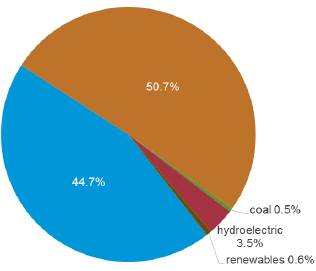Consumption
Egypt is by far the largest consumer of oil and natural gas in Africa, showing 22% of petroleum and other liquids of the continent's total consumption and 37% of its dry natural gas consumption.
The main drivers of the rapid growth of the country's consumption of oil and natural gas can be summarized in the following:
- The increased industrial output.
- Economic growth.
- Intense extraction projects of oil and natural gas.
- Population growth.
- The inclining rate of private and commercial vehicle sales.
- The generous subsidy policy, that is focused on energy products.
Through this sub-chapter, different consumption data will be presented, using different sources, to get a holistic view as possible of the energy consumption situation in the country.
Table.4: Egypt’s Primary Energy Consumption since 1965
| Year | 1965 | 1975 | 1985 | 1995 | 2000 | 2005 | 2010 | 2015 | 2016 | 2017 |
|---|---|---|---|---|---|---|---|---|---|---|
| Rate | 7.8 | 10.5 | 28 | 37.3 | 48.4 | 60.5 | 78.4 | 84.4 | 88.2 | 91.6 |
Table.5: Egypt’s Primary Energy Consumption by Fuel 2016-2017
| Oil | Natural Gas | Coal | Nuclear | Hydro-Electric | Renewable | Total | |
|---|---|---|---|---|---|---|---|
| 2016 | 42 | 42.4 | .2 | - | 3 | .6 | 88.2 |
| 2017 | 39.7 | 48.1 | .2 | - | 3 | .6 | 91.6 |
Table.6: Egypt’s Final Consumption of Different Energy Sources during the 2000s
| 2000 | 2005 | 2012 | 2013 | 2014 | 2015 | 2016 | 2017 | |
|---|---|---|---|---|---|---|---|---|
| Coal | 453 | 203 | 204 | 188 | 188 | 200 | 211 | 224 |
| Oil | 17898 | 20156 | 27009 | 22573 | 26333 | 35213 | 36086 | 37028 |
| Natural Gas | 4274 | 9182 | 12719 | 18202 | 19505 | 20956 | 21446 | 21960 |
| Electricity | 5559 | 7918 | 12060 | 12324 | 12306 | 12668 | 13134 | 13630 |
Table.7: Egypt’s Industrial Consumption of Different Energy Sources during the 2000s
| 2000 | 2005 | 2012 | 2013 | 2014 | 2015 | 2016 | 2017 | |
|---|---|---|---|---|---|---|---|---|
| Oil | 5461 | 5548 | 3716 | 3279 | 3133 | 6369 | 6713 | 7080 |
| Natural Gas | 2072 | 5567 | 6649 | 6789 | 8002 | 9083 | 9303 | 9536 |
| Electricity | 2111 | 2812 | 3430 | 3500 | 3288 | 369 | 3488 | 3612 |
| Coal | 453 | 203 | 204 | 188 | 188 | 200 | 211 | 224 |
Table.8: Egypt’s Transport Consumption of Different Energy Sources during the 2000s
| 2000 | 2005 | 2012 | 2013 | 2014 | 2015 | 2016 | 2017 | |
|---|---|---|---|---|---|---|---|---|
| Oil | 9060 | 9371 | 15547 | 12362 | 16416 | 16892 | 17098 | 17312 |
| Electricity | - | - | 44 | 44 | 45 | 46 | 46 | 47 |
Import and Export
Egypt is a net exporter of crude oil and natural gas, however, the combination of increasing consumption and declining production has led to a decline in natural gas exports since 2009, as the government started to divert natural gas supplies from exports, in order to satisfy domestic demand, eventually turning the country into a natural gas importer since 2015.
In terms of coal and peat, Egypt is a net importer, and coal imports are even expected to increase in the short-medium term, since the Egyptian government has approved the industrial use of coal in April 2014, and in the same year signed a construction deal for the first coal-fired power in the country.
Subsidies
In 2013, the Egyptian government spent 120 billion Egyptian pounds (about 13.8 billion EUR) on fuel subsidies, which equals 7% of the GDP. These costs in combination with economic stagnation have contributed to the increasing deficit, which reached about 12% of GDP in 2013. In order to alleviate this burden, the Egyptian government announced spending cuts on energy subsidies in June 2014. The Financial Times reported that these subsidies are going to be cut by almost a third.

No comments:
Post a Comment